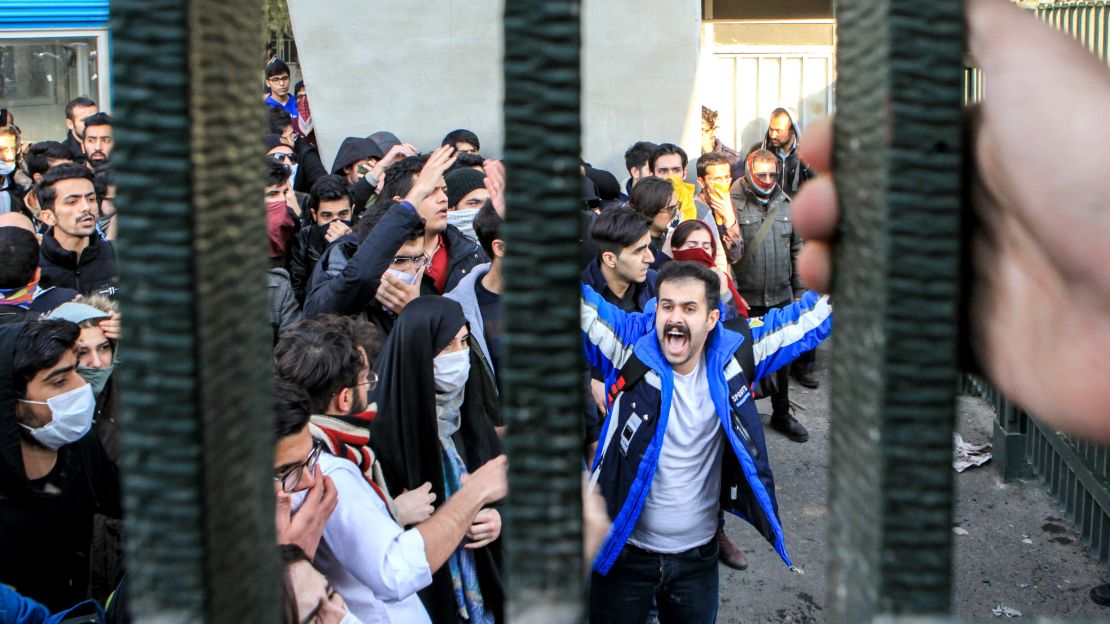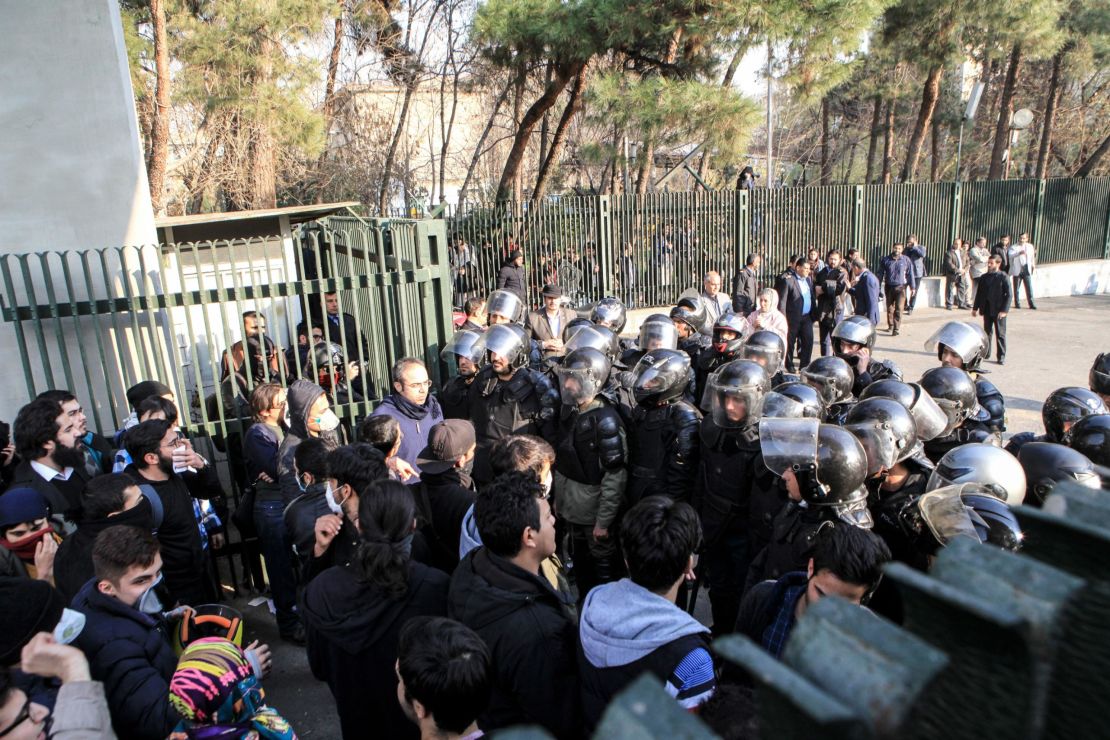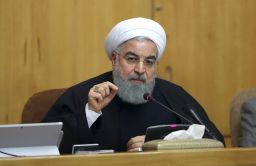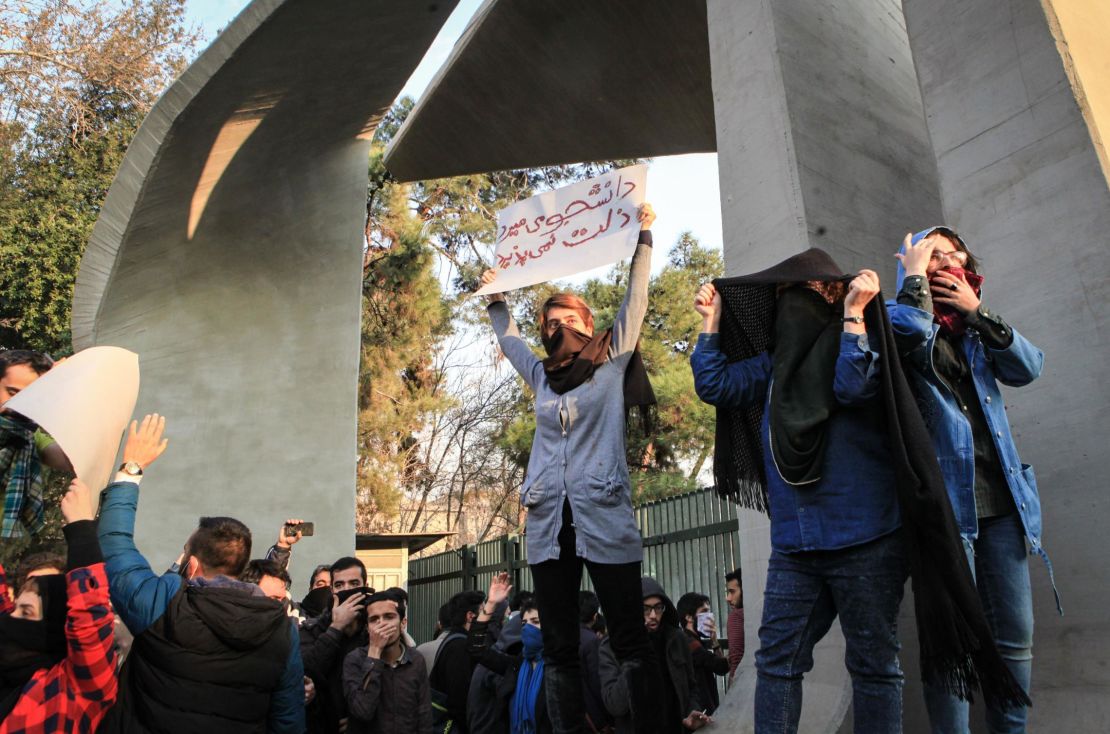Iranian President Hassan Rouhani tried to downplay the significance of sometimes violent protests across his country that have left 12 people dead in the biggest challenge to the authority of the Tehran regime since mass demonstrations in 2009.
“Our great nation has witnessed a number of similar incidents in the past and has comfortably dealt with them. This is nothing,” Rouhani said in a meeting with Iranian members of parliament on Monday.
Rouhani has called for calm as his government deals with the widespread spontaneous uprising.
Latest developments:
– A man “creating a disturbance” shot at police Monday with a hunting rifle, killing one officer and wounding three others, according to state media. The shooting happened in Najafabad.
– Fresh protests broke out in Tehran and other cities, with amateur video showing demonstrators chanting anti-government slogans.
– Rouhani called out Donald Trump after a series of tweets from the US President in support of the protests.
– Russia weighed in, saying the demonstrations are an “internal affair” for Iran and external interference is unacceptable.
– US Vice President Mike Pence tweeted support for protesters, saying “We will not let them down.”
– Rouhani has acknowledged that Iranians have the right to protest legally but urged national unity Monday as “the first and most important step at this stage.”
– A significant Internet outage was reported across Iran on Monday afternoon, but some users said later it was working again.
– Iran’s Ministry of Information said agitators in the disturbances have been identified and arrested, and warned that people participating in illegal activities would be “seriously dealt with.”
How did it all begin?
The protests were sparked by concerns about rising living costs and a stagnant economy, but developed into a broader outcry against the regime.
They are the most serious challenge to Tehran’s authority since the so-called Green Movement of 2009, when millions marched in the capital to protest the re-election of President Mahmoud Ahmadinejad. The opposition alleged the vote was rigged.
Iran has not seen the economic boost that Rouhani, who won re-election in May, had hoped would come after the nuclear deal relieved the country of sanctions and opened it up to international markets. In the spring of 2017, unemployment was 12.6%, up only slightly from 2016, according to the World Bank.
In a nod to the concerns fueling the protests, Rouhani said: “We have no bigger challenge than unemployment. Our economy requires major corrective surgery.”
So far, the latest unrest is on a much smaller scale than 2009. Authorities have yet to launch a wide-ranging crackdown, as they did eight years ago, preferring instead to contain the protests locally.

Fresh protests in Tehran and other cities
Amateur videos posted on social media Monday purport to show anti-government protests for a fifth straight day. The videos showed crowds marching down the streets of different cities, including Tehran, and chanting anti-government slogans. In one video, angry protesters could be heard shouting “death to Khamenei,” referring to Ayatollah Ali Khamenei, Iran’s Supreme Leader.
CNN cannot independently verify the veracity of the videos.
In Tehran, protesters appeared to be playing a game of cat and mouse with police and security forces, according to Los Angeles Times reporter Ramin Mostaghim. He told CNN the police presence outnumbers the mostly younger protesters in the busy Azadi Street, but he saw several protesters yelling “down with the dictator” and sprinting away from police on the side streets. Mostaghim said some trash was lit on fire, but police quickly extinguished it.
Demonstrations turn deadly
One Iranian policeman was shot dead and three others were wounded during a riot in the town of Najafabad, in Isfahan province, south of Tehran, according to the state-run news agency Young Journalist’s Club.
“One rioter in Najafabad took advantage of the situation (in that city) and used a hunting rifle to shoot at security forces, which caused the death of one policeman and injuries to three other security personnel,” the YJC said in a report posted on its website.
Iran’s state broadcaster said six people were killed Sunday in the small western town of Tuyserkan, according to Agence France-Presse (AFP). Six others were killed over the weekend in separate incidents in the neighboring provinces of Lorestan and Khuzestan, according to Iranian news agencies.

Reports Sunday said that as many as 200 people were arrested in the demonstrations. Iran’s Ministry of Information issued a statement saying that a number of agitators in the recent disturbances were identified and arrested, and it provided a telephone number for citizens to report any illegal activity to the ministry, according to the semi-official ISNA (Iranian Students News Agency).
The ministry said more people will be arrested and warned that “they will be seriously dealt with.”
Rouhani: Iranians have the right to protest legally
At a meeting with members of parliament Monday, Rouhani urged national unity, saying it “is the first and most important step at this stage.” He also echoed remarks he made in a pre-recorded appeal for calm aired on state TV Sunday, saying that Iranians had the right to protest legally. “The space needs to open up for legal protest and criticism,” he said.
But he drew the line at outside interference after Trump commented on the demonstrations. Rouhani said that Trump had no right to sympathize with Iran because he has previously called the Iranian people “terrorists” and has been “constantly creating problems” for Iran since being elected, according to Iran’s semi-official Tasnim News Agency.
Trump weighed in again on Monday, posting: “Iran is failing at every level despite the terrible deal made with them by the Obama administration. The great Iranian people have been repressed for many years. They are hungry for food & for freedom. Along with human rights, the wealth of Iran is being looted. TIME FOR CHANGE!”

British Foreign Minister Boris Johnson called for “meaningful debate about the legitimate and important issues the protesters are raising.”
In a Facebook message, Johnson called on Iranian authorities to permit dissent and stressed the importance of freedom of expression and peaceful demonstrations.
Russia called the protests an “internal affair” for Iran. The Russian Foreign Ministry added that “external interference destabilizing the situation is unacceptable” and said it hopes the demonstrations “won’t develop under the scenario of bloodshed and violence,” state-run Russian news agencies Tass and Sputnik reported.
Rouhani hinted that forces outside Iran are behind the protests and said his country’s “progress and development has angered our enemies.”
Social media sites restricted
State-run media outlet IRIB reported Sunday that officials had temporarily restricted access to social media apps Instagram and Telegram, which have been used by Iranians to share news about the protests. Iran’s Minister for Communications and Technology Azari Jahromi denounced the reports as “rumors” in a post on Twitter.

Two US presidents on two Iranian crackdowns
Social media has helped galvanize tens of thousands participating in the protests, which have taken place in towns and cities across Iran. The unrest appears to have begun with hard-line agitators encouraging protests against Rouhani. But they quickly lost control of events and demonstrations have taken on a general anti-regime feel.
Monday afternoon, Internet outages were reported across the country, according to Oracle’s Internet Intelligence, a global research site that monitors Internet activity. A CNN producer in Tehran said the Internet was out for about an hour before coming back on. The producer spoke with people in other cities and they said they were experiencing intermittent Internet outages.

In a rare act of defiance, some protesters have even called for the resignation of Khamenei.
In some demonstrations, women cast off their hijabs, defying the country’s strict Islamic dress code. The protests have provided an opening for Iranian women to push for equal rights.
Video shared on social media captured Iranians chanting “We don’t want an Islamic Republic” and “Death to the dictator.” CNN has not independently verified the authenticity of the footage, purportedly shot in the western city of Khorramabad.
CNN’s Spencer Feingold, Yousuf Basil, Jennifer Hauser, Pamela Boykoff, Samuel Burke, Julia Jones and Mary Ilyushina contributed to this report.






















